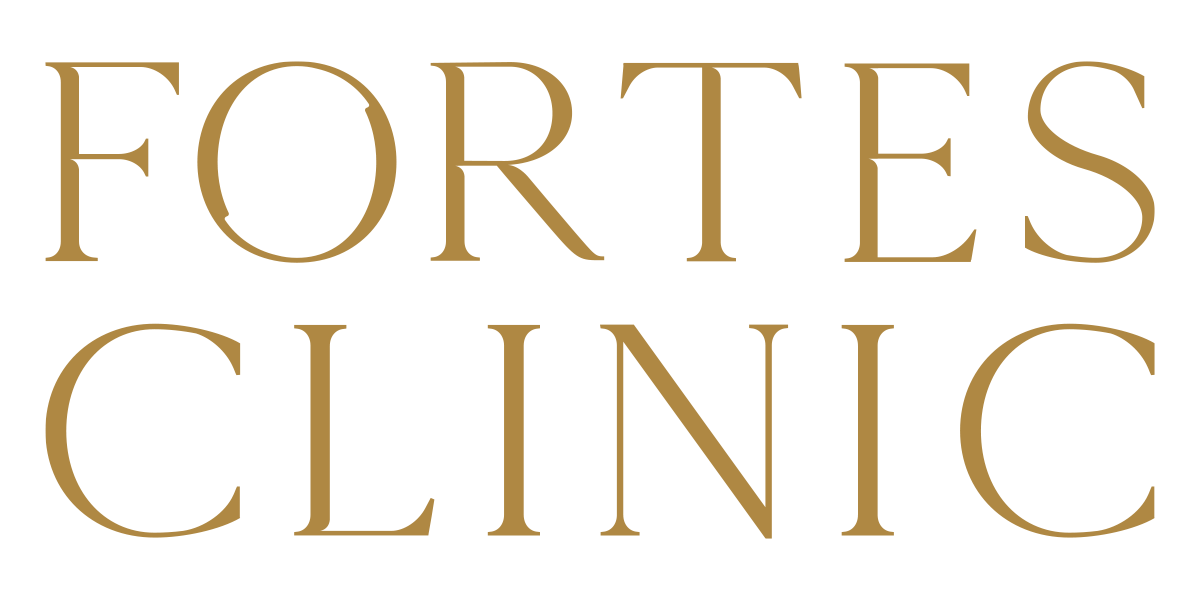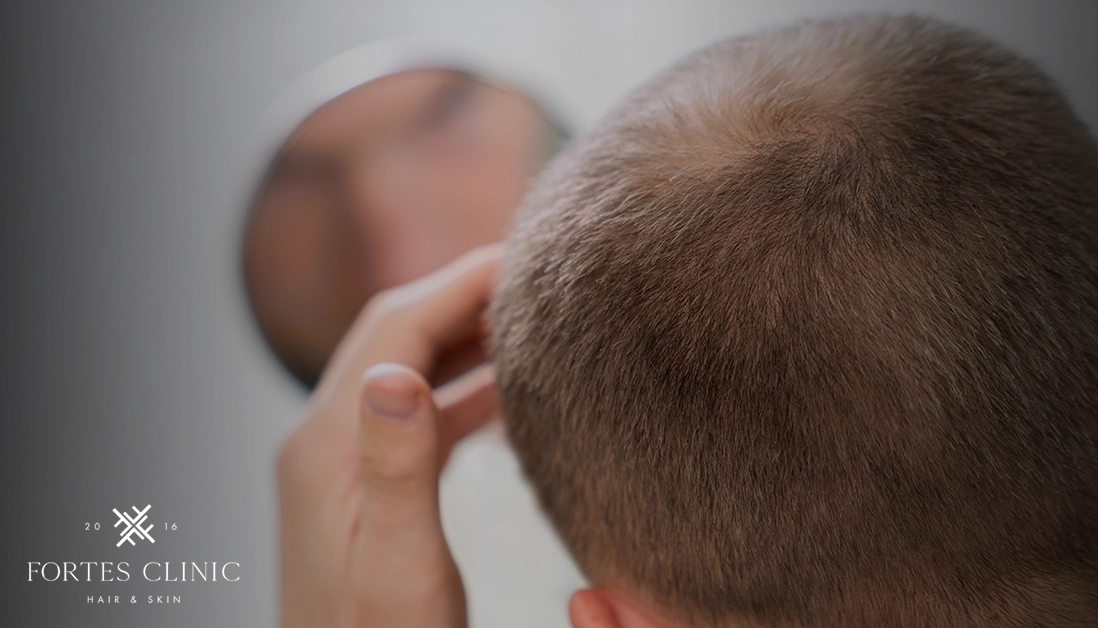Introduction to Hair Transplantation
Embarking on the journey of hair restoration is a significant decision. It’s one that can profoundly impact not just your appearance but also your self-confidence and quality of life. This comprehensive guide aims to walk you through every step of the process. We place particular focus on the expertise and offerings of our team at Fortes Clinic, a leader in the field of hair transplant treatment.
Understanding Hair Transplant
Hair transplantation is a surgical technique that moves individual hair follicles from a part of the body, known as the ‘donor site’, to a bald or balding part of the body known as the ‘recipient site’. It’s particularly common to treat male pattern baldness. In this minimally invasive procedure, grafts containing hair follicles that are genetically resistant to balding, like the ones on the back of the head, are transplanted to the bald scalp.
Hair transplant can also restore eyelashes, eyebrows, beard hair, chest hair, and to fill in scars resulting from accidents or surgery. This may include face-lifts and previous hair transplants. It’s a solution that promises not just hair growth but also a restoration of confidence.
The Evolution of Hair Transplant Techniques
The field of hair transplantation has evolved significantly over the years. Advancements in technology and technique enhancing both the effectiveness and aesthetics of the outcome. From the early days of large grafts and ‘pluggy’ looks, we have moved to an era of micrografts and follicular unit transplants. These offer natural-looking results. Today, cutting-edge techniques like Follicular Unit Extraction (FUE hair transplant) and Follicular Unit Transplantation (FUT hair transplant) provide more refined results, reduced recovery times, and minimised scarring.
Understanding these techniques and the nuances involved in hair transplantation is crucial in setting realistic expectations and making informed decisions. In the subsequent sections, we’ll delve deeper into why Fortes Clinic stands out in this specialised field. We’ll look at the different hair transplant procedures available and how to prepare for your transplant. Finally, we’ll cover what you can expect in terms of care, recovery, and results.
This guide is your first step towards understanding and embarking on your hair restoration journey with confidence.
Why Choose Fortes Clinic for Your Hair Transplant?
Selecting the right clinic for your hair transplant is a pivotal decision. It’s one that will influence not only the success of the procedure but also your overall experience. Fortes Clinic stands out as a leading choice, thanks to our combination of expert medical professionals, state-of-the-art technology, and personalised patient care. Here’s a closer look at what makes Fortes Clinic the preferred choice for those seeking hair transplant solutions.
Expertise and Experience at Fortes Clinic
The cornerstone of Fortes Clinic’s reputation is its team of highly skilled and experienced surgeons. These professionals are not just practitioners; they are thought leaders in the field of hair restoration. They contribute to significant advancements in hair transplant technology. With years of specialist experience, they bring an unparalleled depth of knowledge to each procedure. This expertise ensures that every patient receives a level of care and precision that is specific to their individual needs for optimal results.
Cutting-Edge Technology and Techniques
Innovation is at the heart of Fortes Clinic’s approach to hair transplantation. The clinic possesses the latest technology and employs leading surgical techniques available today. This commitment to using cutting-edge tools and methods minimises patient discomfort, reduces recovery time, and importantly, enhances the natural appearance of the hair transplant. Whether it’s Follicular Unit Extraction (FUE), Follicular Unit Transplantation (FUT), or more advanced techniques, patients can rest assured they are receiving the best possible treatment.
Personalised Care and Attention
At Fortes Clinic, we understand that each patient’s journey towards hair restoration is unique. This belief drives our commitment to providing bespoke care and attention. From the initial consultation to the final follow-up, our team ensures that every aspect of your treatment is specific to your specific needs and preferences. We take the time to understand your hair loss pattern, lifestyle, and desired outcomes. This comprehensive approach helps us design a treatment plan that perfectly aligns with your vision for hair restoration.
Choosing Fortes Clinic means more than just selecting a hair transplant service. It means entering into a partnership with a dedicated team. This team has a commitment not only to restoring your hair but also to enhancing your confidence and overall quality of life. In the next sections, we’ll explore the various hair transplant procedures available at Fortes Clinic. We’ll explain how to prepare for them, and what you can expect in terms of care, recovery, and results.
Your journey to hair restoration starts with making an informed choice. Fortes Clinic is here to guide you every step of the way.
Types of Hair Transplant Procedures
A crucial step in your hair restoration journey is understanding the different types of hair transplant procedures available. At Fortes Clinic, we pride ourselves on offering a variety of options to suit individual needs and preferences. This section provides an overview of the main procedures available. We assist you in make a good decision about which is optimal to your requirements.
Follicular Unit Transplantation (FUT)
FUT, commonly known as the ‘strip method’, involves removing a strip of scalp from the donor area (usually the back of the head) and extracting individual follicular units from this strip. These units are then transplanted to the recipient area.
Process of FUT
The FUT process begins with the administration of local anaesthesia to numb the donor area. We then carefully remove a strip of scalp, and the incision is closed with sutures. The strip is meticulously dissected under a microscope to isolate individual follicular units, which are then prepared for transplantation. We strategically place the units in the balding areas to create a natural-looking hairline and density.
Pros and Cons
FUT is beneficial for its ability to transfer a large number of grafts in a single session, making it an ideal choice for extensive hair loss. However, it does leave a linear scar in the donor area. You can conceal this with surrounding hair. The recovery period might be slightly longer compared to other methods, and some discomfort can be expected during the healing process.
Follicular Unit Extraction (FUE)
In FUE, we extract individual follicular units directly from the scalp using a precise circular tool. This method is known for its ability to leave minimal scarring and promote a quicker recovery.
Process of FUE
During FUE, we harvest each follicular unit individually from the donor area using a punch device. This method minimises scarring and speeds up the recovery process. The follicles we extract are then carefully implanted into the balding areas. This ensures a natural distribution and growth pattern.
Pros and Cons
The main advantage of FUE is its scarless technique. It allows patients to wear their hair short without worry. The procedure is less invasive than FUT, with a shorter recovery time. However, it may require multiple sessions to achieve the desired coverage, especially in cases of significant balding.
Advanced Techniques and Innovations
Fortes Clinic is also at the forefront of advanced hair transplant techniques, offering innovative treatments that combine the best aspects of FUT and FUE.
Platelet-Rich Plasma (PRP) Therapy
PRP therapy involves the injection of a concentration of platelet-rich plasma derived from your blood into the scalp. This treatment stimulates hair growth and we often use it alongside transplant procedures to enhance results.
Each of these procedures has distinct advantages, and our experts at Fortes Clinic will guide you in choosing the one that best aligns with your hair restoration goals. The next section will cover how to prepare for your hair transplant, setting the stage for a successful and comfortable experience.
Preparing for Your Hair Transplant
Preparing for a hair transplant is an essential part of the journey towards hair restoration. Proper preparation ensures not only the success of the procedure but also a smoother, more comfortable experience. At Fortes Clinic, we guide our patients through each step of the preparation process. This section outlines what you can expect and how best to prepare for your hair transplant procedure.
Initial Consultation and Evaluation
The first step is an in-depth consultation with one of our specialists. This consultation is crucial for understanding your hair loss pattern, discussing your expectations, and determining the most suitable procedure for you. During this session, our expert will evaluate your scalp and hair, discuss your medical history, and answer any questions you might have. This is your opportunity to express your desired outcomes and any concerns you may have.
Pre-Procedure Guidelines
Once you’ve decided to proceed with the hair transplant, you’ll receive a set of pre-procedure guidelines. These are designed to prepare your scalp for surgery and to ensure the best possible outcome. Common recommendations include:
- Avoiding certain medications, such as aspirin or other blood thinners, which might increase bleeding during the procedure.
- Refraining from smoking and alcohol consumption for a specified period before the surgery, as these can affect the healing process.
- Not cutting your hair short before the procedure, especially if you’re undergoing FUT, as longer hair can help cover the sutures post-surgery.
What to Expect on the Day of Surgery
On the day of the surgery, you should arrive at the clinic well-rested and having eaten a light meal. We recommend wearing comfortable clothing and arranging for someone to drive you home after the procedure.
We carry out the procedure itself under local anaesthesia. This means you’ll be awake but will not feel any pain in the treatment area. Depending on the type of procedure and the number of grafts being transplanted, the surgery can take anywhere from four to eight hours. Throughout the procedure, our team will ensure you are comfortable and will provide breaks as necessary.
Preparing for your hair transplant is a straightforward process, but it plays a vital role in the success of your treatment. At Fortes Clinic, we are committed to providing you with all the guidance and support you need to ensure you are fully prepared for this life-changing procedure. In the following sections, we will discuss the hair transplant procedure at Fortes Clinic and the post-transplant care and recovery process.
The Hair Transplant Procedure at Fortes Clinic
The day of your hair transplant at Fortes Clinic is a significant milestone on your journey towards hair restoration. Our team is committed to providing a procedure that is not only successful but also comfortable and reassuring for you. This section outlines what you can expect during the hair transplant procedure at our clinic.
Step-by-Step Process
On the day of your procedure, you will receive a welcome by our team. They will ensure you are relaxed and ready for the surgery. The process typically unfolds as follows:
- Preparation: The treatment area on your scalp will be cleaned and then local anaesthesia will be administered to ensure a pain-free experience.
- Donor Hair Extraction: Depending on the chosen method (FUT or FUE), donor hair will be extracted. In FUT, a strip of scalp is removed, and in FUE, individual follicles are extracted.
- Follicle Preparation: Extracted follicles are carefully prepared under a microscope. This step is crucial for ensuring the viability and optimal placement of the grafts.
- Transplantation: The prepared follicles are then meticulously implanted into the recipient areas. This is done with great care to achieve a natural-looking hair density and hairline.
- Closing the Procedure: Once all grafts are placed, the scalp is cleaned, and if necessary, sutures are applied to the donor area (in FUT).
The entire process can take several hours, depending on the extent of the transplant. Our staff will be with you throughout, ensuring your comfort and addressing any needs that arise.
Ensuring Comfort and Safety
Your comfort and safety are our top priorities. Throughout the procedure, our team monitors your well-being, offering breaks and reassurance as necessary. We use specialist pain management techniques to minimise discomfort. Our state-of-the-art facilities are designed to provide a safe and sterile environment.
Monitoring and Adjustments During Surgery
Our surgeons have vast experience in adapting the procedure as it progresses. They continuously monitor the placement and density of the grafts, making adjustments as needed to achieve the best aesthetic and practical results.
Undergoing a hair transplant at Fortes Clinic means receiving top-notch care from a team of professionals dedicated to achieving the best possible outcomes. In the next section, we will discuss the post-transplant care and recovery process. We ensure you have all the necessary information about what to expect following your procedure.
Post-Transplant Care and Recovery
After your hair transplant procedure at Fortes Clinic, proper care and attention during the recovery period are vital for achieving the best results. This section provides guidance on post-transplant care, helping you navigate through the recovery process smoothly and effectively.
Immediate Post-Procedure Care
Immediately following the procedure, you will receive in-depth aftercare instructions. These typically include:
- Wound Care: If you have undergone an FUT procedure, you will have a linear wound in the donor area that needs to be kept clean and dry. For FUE, small red dots in the donor area will heal over the following week.
- Pain Management: Some discomfort or mild pain is normal post-surgery. You will be prescribed or advised over-the-counter pain relief to manage any discomfort.
- Swelling Management: It’s common to experience some swelling in the scalp and forehead area. Instructions on how to reduce swelling, such as sleeping in an elevated position, will be provided.
- Hair Washing Guidelines: Specific instructions on how to wash your hair without disturbing the transplanted grafts will be given. Gentle washing usually starts a few days post-surgery.
Long-Term Hair Care and Maintenance After A Hair Transplant
Caring for your transplanted hair over the long term is crucial for maintaining the health and appearance of your new hair. Tips for long-term care include:
- Avoiding Harsh Chemicals: In the initial weeks post-transplant, avoid using harsh chemicals, dyes, or styling products on your hair.
- Nutrition and Hydration: A healthy diet and staying hydrated can support hair growth and overall scalp health.
- Gentle Styling: Once your scalp has fully healed, you can return to your normal hair care routine, but it’s advisable to treat your hair gently, especially in the early stages of growth.
Dealing with Potential Hair Transplant Side Effects
While hair transplants are generally safe, being aware of potential side effects is important. These can include temporary thinning of pre-existing hair, known as shock loss, which usually recovers over time. If you notice any unusual symptoms or have concerns, our team is available for post-operative consultations.
Follow-Up Appointments
Follow-up appointments are an essential part of the post-transplant process. These allow us to monitor your healing and the progress of your new hair growth. They also provide an opportunity to address any concerns or questions you may have.
Recovery from a hair transplant is a journey. Tt Fortes Clinic, we have a strong commitment to supporting you every step of the way. The final outcome – a fuller, natural-looking head of hair – is typically seen several months after the procedure. This occurs as the transplanted follicles enter a new growth cycle.
Expected Outcomes from Fortes Clinic Procedures
The results of a hair transplant are gradual and typically become noticeable within three to six months post-surgery, with the full impact often visible after a year. The transplanted hair initially falls out — a normal part of the process — before growing back stronger and healthier. Here’s what you can generally expect:
- Natural-Looking Hairline: Our expert surgeons ensure that the transplanted hair blends seamlessly with your existing hair, creating a natural and undetectable hairline.
- Increased Density: The transplanted areas will exhibit a significant improvement in density, helping to cover bald spots and thinning areas effectively.
- Long-Term Results: Transplanted hair, being resistant to the hormones that cause balding, typically continues to grow for a lifetime.
Please visit our gallery to view some previous results of our industry-leading hair transplant procedures.
If you would like further information, please feel free to contact our friendly team and they will respond swiftly to any queries you may have.



